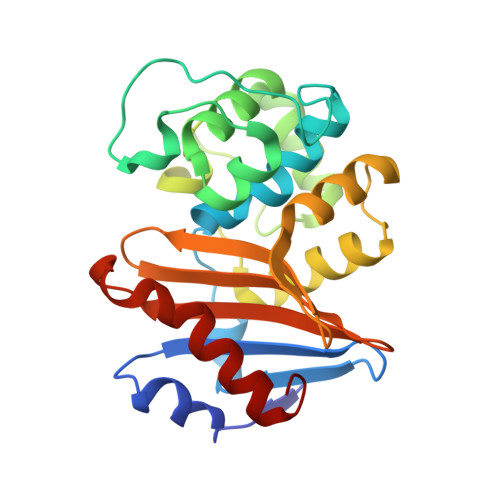Mechanistic Basis of OXA-48-like beta-Lactamases' Hydrolysis of Carbapenems.
Stojanoski, V., Hu, L., Sankaran, B., Wang, F., Tao, P., Prasad, B.V.V., Palzkill, T.(2021) ACS Infect Dis 7: 445-460
- PubMed: 33492952
- DOI: https://doi.org/10.1021/acsinfecdis.0c00798
- Primary Citation of Related Structures:
7KH9, 7KHQ, 7KHY, 7KHZ - PubMed Abstract:
Carbapenem-hydrolyzing class D β-lactamases (CHDLs) are an important source of resistance to these last resort β-lactam antibiotics. OXA-48 is a member of a group of CHDLs named OXA-48-like enzymes. On the basis of sequence similarity, OXA-163 can be classified as an OXA-48-like enzyme, but it has altered substrate specificity. Compared to OXA-48, it shows impaired activity for carbapenems but displays an enhanced hydrolysis of oxyimino-cephalosporins. Here, we address the mechanistic and structural basis for carbapenem hydrolysis by OXA-48-like enzymes. Pre-steady-state kinetic analysis indicates that the rate-limiting step for OXA-48 and OXA-163 hydrolysis of carbapenems is deacylation and that the greatly reduced carbapenemase activity of OXA-163 compared to that of OXA-48 is due entirely to a slower deacylation reaction. Furthermore, our structural data indicate that the positioning of the β5-β6 loop is necessary for carbapenem hydrolysis by OXA-48. A major difference between the OXA-48 and OXA-163 complexes with carbapenems is that the 214-RIEP-217 deletion in OXA-163 creates a large opening in the active site that is absent in the OXA-48/carbapenem structures. We propose that the larger active site results in less constraint on the conformation of the 6α-hydroxyethyl group in the acyl-enzyme. The acyl-enzyme intermediate assumes multiple conformations, most of which are incompatible with rapid deacylation. Consistent with this hypothesis, molecular dynamics simulations indicate that the most stable complex is formed between OXA-48 and imipenem, which correlates with the OXA-48 hydrolysis of imipenem being the fastest observed. Furthermore, the OXA-163 complexes with imipenem and meropenem are the least stable and show significant conformational fluctuations, which correlates with the slow hydrolysis of these substrates.
- Department of Molecular Biophysics and Integrated Bioimaging, Berkeley Center for Structural Biology, Lawrence Berkeley National Laboratory, Berkeley, California 94720, United States.
Organizational Affiliation:



















